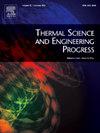Does swirl number affect the radiative and convective heat transfer from diffusion hydrogen-methane blended flames?
IF 5.1
3区 工程技术
Q2 ENERGY & FUELS
引用次数: 0
Abstract
Industries are exploring hydrogen fuel switching to achieve net-zero targets. Pure hydrogen combustion eliminates carbon dioxide emissions, but this could adversely affect the heating performance since much of the radiative heat transfer from hydrocarbon flames originates from hot carbon dioxide molecules and soot particles, absent from hydrogen combustion.
To investigate the effect of swirl number on a flame’s heat transfer, a generic swirl burner was operated at 25 kW thermal input, with three geometric swirl numbers, a fixed equivalence ratio of 1.0 and methane-hydrogen blends of 0–100 % by volume. Hydrogen and methane exhibited different radiative and convective heat transfer properties.
Results showed that increasing geometric swirl number produced shorter flames with lower radiative heat transfer. The maximum radiative heat flux of a flame occurred between ∼50–70 % along the flame’s length. Increasing hydrogen blending resulted in an increased flame temperature. 25–50 % hydrogen blending enhanced methane flame’s radiative heat transfer, while further blending reduced it. Local convective heat flux correlated well with local gas temperature, regardless of fuel.
The ratio of radiation to convection was greatest early in the flame, with convection increasing along the flame’s length. Both heat transfer modes decreased at similar rates with radial distance from the burner centreline.
This study examined the temperature of a steel slab using a thermocouple array to analyse heat transfer. While the hypothesis was not confirmed, results showed process temperatures are influenced by multiple factors. Steel temperatures were setup specific. Heat flux, flame, and product temperature measurements provided a strong heat transfer assessment.
求助全文
约1分钟内获得全文
求助全文
来源期刊

Thermal Science and Engineering Progress
Chemical Engineering-Fluid Flow and Transfer Processes
CiteScore
7.20
自引率
10.40%
发文量
327
审稿时长
41 days
期刊介绍:
Thermal Science and Engineering Progress (TSEP) publishes original, high-quality research articles that span activities ranging from fundamental scientific research and discussion of the more controversial thermodynamic theories, to developments in thermal engineering that are in many instances examples of the way scientists and engineers are addressing the challenges facing a growing population – smart cities and global warming – maximising thermodynamic efficiencies and minimising all heat losses. It is intended that these will be of current relevance and interest to industry, academia and other practitioners. It is evident that many specialised journals in thermal and, to some extent, in fluid disciplines tend to focus on topics that can be classified as fundamental in nature, or are ‘applied’ and near-market. Thermal Science and Engineering Progress will bridge the gap between these two areas, allowing authors to make an easy choice, should they or a journal editor feel that their papers are ‘out of scope’ when considering other journals. The range of topics covered by Thermal Science and Engineering Progress addresses the rapid rate of development being made in thermal transfer processes as they affect traditional fields, and important growth in the topical research areas of aerospace, thermal biological and medical systems, electronics and nano-technologies, renewable energy systems, food production (including agriculture), and the need to minimise man-made thermal impacts on climate change. Review articles on appropriate topics for TSEP are encouraged, although until TSEP is fully established, these will be limited in number. Before submitting such articles, please contact one of the Editors, or a member of the Editorial Advisory Board with an outline of your proposal and your expertise in the area of your review.
 求助内容:
求助内容: 应助结果提醒方式:
应助结果提醒方式:


